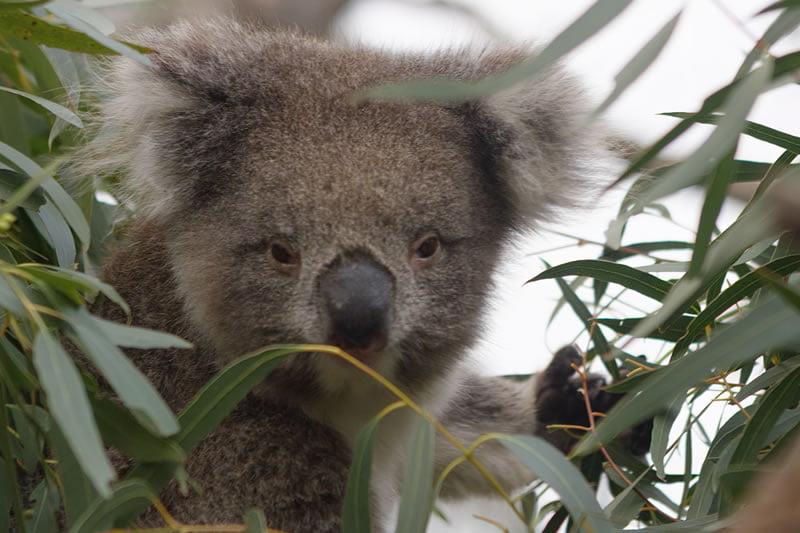A focus on wildlife at HVP Plantations is helping South Australia’s koalas breed strong.
Over 15 years of work on koala safety is paying off for HVP Plantations. Recently, the private plantation company responded to a request from the South Australian Government to relocate six male Strzelecki koalas from HVP managed Gippsland eucalypt forests to a koala breeding program at SA’s Cleland Wildlife Park (CWP).
These koalas have robust genetics and are considered a good choice to support and strengthen the SA koala gene pool. As in much of Australia, koalas have been badly affected by drought, huge fires and floods, as well as habitat loss and disease.
“Some portions of the Australian koala population suffer from what is known as a ‘genetic bottleneck’, a by-product of coming close to extinction, and then repopulating from just a handful of the remaining population,” Tim McBride, HVP Plantations Environment and Certification Manager, says.
“The weak gene pool has led to some koalas being more susceptible to kidney and renal failure, among other inflictions such as chlamydia. Strzelecki koalas have a complex genetic makeup that sees them better equipped to deal with the onset of diseases such as chlamydia.”
Too often, forestry and wildlife are framed as adversarial forces by voices on both sides. In reality, foresters and ecologists often work together closely, attempting to maximise the health of these environments and minimise the impacts of harvesting.
For this project, working with a team from Koala Life and in partnership with CWP and the Victorian and SA governments, HVP humanely caught four adult male koalas, who were given health checks before being driven to their new home across the state border.
“HVP Plantations are very fortunate to have a healthy Strzelecki koala population within our Gippsland eucalypt plantations,” says McBride, who studied Wildlife Science at the University of Washington in Seattle.
“It’s definitely been a long journey for HVP,” McBride says. “We started being mindful about koalas and our harvesting practices some 16 or 18 years ago.
“As part of this, we engaged two experts in koala ecology here in Victoria, Dr Peter Menkhorst, and Dr Steve Phillips. With those scientific minds, we developed a new management plan around how we would minimise the impacts of harvesting on such an iconic Australian critter.”
Since 2014, the plan has been refined in a series of practical developments. The first step is identifying risk to koalas at each operation site. “That starts at a desktop planning stage,” says McBride. “We spent a lot of years with the ecologists learning about koala habitat and preferential feed trees and things like that. We’ve built up our knowledge of the surrounding habitat outside the intensively managed blue gum, and other eucalypt plantations that we have. This helps us to identify risks to the animals that might be within our plantations and whether it’s a high, medium or low risk. Once we’ve established that at risk index, then we set about developing an actual survey plan.”
HVP works with Hazelwood Forestry, based in nearby Churchill. “They’ve pioneered the use of drones in our local area,” McBride says. “They use expensive, forward looking infrared cameras on their drones and they go out before any kind of operation.”
Because the cameras work on heat signatures, the crew do their work at 3am when the differential heat signatures between mammals and the surrounding environment are greatest.
“They can locate koalas throughout hectares of our plantation with these awesome tools,” McBride says. “And we can pinpoint those locations and follow them up in the daytime to make sure that we’ve got the right tree. We send that specific location information to our harvesting contractors through phone-based apps and they then have real-time information about where these animals are, relative to our machinery.”
Operations are directed away from koala populations and day spotters are used to check that a population has moved away from nearby harvesting before the machinery moves at all in their direction.
As McBride says: “We ensure the animals have a very easy time understanding that something is changing, and they’re encouraged to move out of the area. We organise our harvesting so that we’re strategic about not blocking off the animals’ movement corridors and keeping generations of feed trees available.”
Regular follow-up inspections confirm animal movements, with live updates going out to all active operations. The data also helps HVP to plan for changes after natural disasters, such as fires, where more koalas might require feed trees for some years, or urgent wildlife rescue intervention.
The result is a Forest Management Plan that will tie in well with the new draft Victorian Koala Management Strategy and which already acts as a resource for groups like CWP. “Although we only caught four, not six,” McBride jokes. “Which means we were slightly outsmarted by koalas.”
For more, visit www.hvp.com.au












